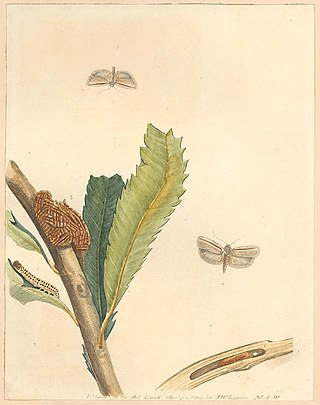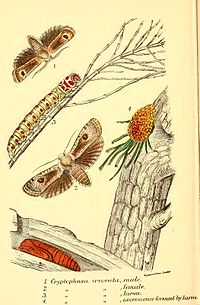
Xyloryctidae is a family of moths contained within the superfamily Gelechioidea described by Edward Meyrick in 1890. Most genera are found in the Indo-Australian region. While many of these moths are tiny, some members of the family grow to a wingspan of up to 66 mm, making them giants among the micromoths.

Cryptophasa is a genus of moths of the family Xyloryctidae.
Cryptophasa leucadelpha is a moth in the family Xyloryctidae. It was described by Edward Meyrick in 1887. It is found in Australia, where it has been recorded from New South Wales, Queensland and Victoria.
Cryptophasa ochroleuca is a moth in the family Xyloryctidae. It was described by Oswald Bertram Lower in 1892. It is found in Australia, where it has been recorded from the Australian Capital Territory, New South Wales, South Australia and Victoria.

Cryptophasa albacosta, the small fruit tree borer, is a moth in the family Xyloryctidae. It was described by John Lewin in 1805. It is found in Australia, where it has been recorded from New South Wales, Queensland, South Australia, Tasmania and Victoria.
Cryptophasa gypsomera is a moth in the family Xyloryctidae. It was described by Oswald Bertram Lower in 1903. It is found in Australia, where it has been recorded from New South Wales and Victoria.
Cryptophasa lasiocosma is a moth in the family Xyloryctidae. It was described by Oswald Bertram Lower in 1908. It is found in Australia, where it has been recorded from Queensland and New South Wales.
Cryptophasa chionacra is a moth in the family Xyloryctidae. It was described by Alexey Diakonoff in 1954. It is found in New Guinea.
Cryptophasa chlorotis is a moth in the family Xyloryctidae. It was described by Alexey Diakonoff in 1954. It is found in New Guinea.
Cryptophasa geron is a moth in the family Xyloryctidae. It was described by Alexey Diakonoff in 1954. It is found in New Guinea.
Cryptophasa hades is a moth in the family Xyloryctidae. It was described by Alexey Diakonoff in 1954. It is found in New Guinea.
Cryptophasa iorhypara is a moth in the family Xyloryctidae. It was described by Alexey Diakonoff in 1954. It is found in New Guinea.
Cryptophasa niphadobela is a moth in the family Xyloryctidae. It was described by Alexey Diakonoff in 1954. It is found in New Guinea.
Cryptophasa obscura is a moth in the family Xyloryctidae. It was described by Alexey Diakonoff in 1954. It is found in New Guinea.
Cryptophasa ranunculus is a moth in the family Xyloryctidae. It was described by Alexey Diakonoff in 1954. It is found in New Guinea.
Cryptophasa psiloderma is a moth in the family Xyloryctidae. It was described by Alexey Diakonoff in 1948. It is found in New Guinea.
Cryptophasa psathyra is a moth in the family Xyloryctidae. It was described by Alexey Diakonoff in 1948. It is found in New Guinea.
Cryptophasa antalba is a moth in the family Xyloryctidae. It was described by Alexey Diakonoff in 1966. It is found in New Guinea.
Cryptophasa russata is a moth in the family Xyloryctidae. It was described by Arthur Gardiner Butler in 1877. It is found in New Guinea and Australia, where it has been recorded from Queensland and New South Wales.

Xylorycta strigata, the banksia web-covering borer, is a moth in the family Xyloryctidae. It was described by John Lewin in 1805. It is found in Australia, where it has been recorded from New South Wales, Queensland and South Australia.





